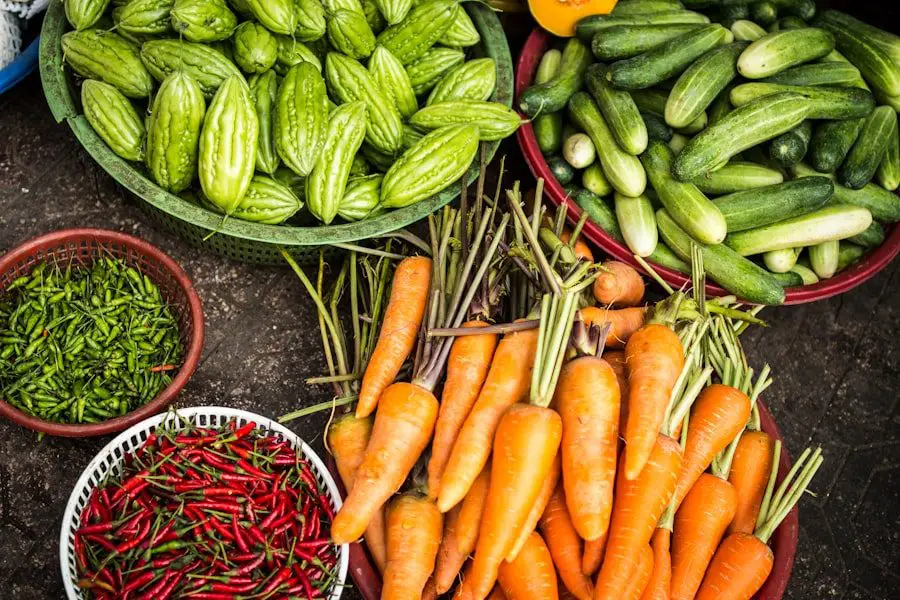
Desi spices are an integral part of Indian cuisine, known for their vibrant flavors and aromatic profiles. Derived from various plants, seeds, and roots, these spices are used to enhance the taste and depth of dishes. From the fiery heat of chili powder to the earthy warmth of cumin, Desi spices add a burst of flavors that can transform any meal.
In Indian cuisine, spices are not just used for their taste, but also for their medicinal properties. The use of spices in cooking dates back thousands of years and is deeply rooted in Indian culture. Each spice has its own unique health benefits, making them more than just a flavor enhancer.
Key Takeaways
- Desi spices offer a burst of flavor to your meals and can enhance your culinary experience.
- Desi spices have numerous health benefits, including anti-inflammatory and antioxidant properties.
- The top 5 must-have desi spices in your kitchen are cumin, coriander, turmeric, garam masala, and chili powder.
- Easy desi spice recipes can be incorporated into your everyday meals, such as adding cumin to roasted vegetables or turmeric to scrambled eggs.
- Desi spices can also be used in Western dishes, such as adding garam masala to a chicken pot pie or using turmeric in a marinade for grilled chicken.
The Health Benefits of Desi Spices: More Than Just Flavor
Desi spices offer a wide range of health benefits that go beyond just adding flavor to your meals. Many spices have been used in traditional Ayurvedic medicine for centuries due to their healing properties. For example, turmeric is known for its anti-inflammatory properties and is often used to treat arthritis and other inflammatory conditions.
Cumin is another popular spice that aids in digestion and helps relieve bloating and gas. It is also believed to have antimicrobial properties that can help fight off infections. Cardamom, on the other hand, is known for its ability to improve digestion and freshen breath.
The Top 5 Must-Have Desi Spices in Your Kitchen
When it comes to Desi spices, there are a few that are considered essential in every Indian kitchen. These spices not only add flavor to dishes but also provide a unique taste profile that is characteristic of Indian cuisine.
1. Turmeric: Known for its vibrant yellow color, turmeric adds a warm and earthy flavor to dishes. It is commonly used in curries, rice dishes, and even beverages like golden milk. Turmeric is also known for its anti-inflammatory and antioxidant properties.
2. Cumin: Cumin seeds have a warm and nutty flavor that is commonly used in Indian cooking. They can be used whole or ground and are often added to curries, soups, and rice dishes. Cumin is known for its digestive benefits and is believed to help relieve bloating and gas.
3. Coriander: Coriander seeds have a citrusy and slightly sweet flavor that is commonly used in Indian curries, chutneys, and marinades. Ground coriander is also a key ingredient in many spice blends. Coriander is believed to aid digestion and has antioxidant properties.
4. Cardamom: Cardamom pods have a sweet and floral flavor that is commonly used in both sweet and savory dishes. It is often added to desserts, chai tea, and rice dishes. Cardamom is known for its digestive benefits and is believed to help freshen breath.
5. Chili Powder: Chili powder adds heat and spice to dishes, ranging from mild to extremely hot depending on the variety used. It is commonly used in curries, marinades, and spice blends. Chili powder is believed to have metabolism-boosting properties.
Easy Desi Spice Recipes for Your Everyday Meals
| Recipe Name | Preparation Time | Cooking Time | Servings | Calories per Serving |
|---|---|---|---|---|
| Easy Chicken Curry | 10 minutes | 25 minutes | 4 | 300 |
| Spicy Lentil Soup | 15 minutes | 30 minutes | 6 | 200 |
| Vegetable Biryani | 20 minutes | 45 minutes | 8 | 350 |
| Chickpea Masala | 10 minutes | 20 minutes | 4 | 250 |
Incorporating Desi spices into your everyday meals doesn’t have to be complicated. Here are a few simple recipes that showcase the flavors of these spices:
1. Turmeric Roasted Vegetables: Toss your favorite vegetables with olive oil, turmeric, salt, and pepper. Roast in the oven until tender and golden brown.
2. Cumin-Spiced Lentil Soup: Sauté onions, garlic, and cumin seeds in olive oil until fragrant. Add lentils, vegetable broth, and your choice of vegetables. Simmer until the lentils are cooked through.
3. Coriander Chicken Curry: Sauté onions, garlic, and ground coriander in oil until fragrant. Add chicken pieces and cook until browned. Stir in coconut milk, tomato paste, and spices like turmeric and chili powder. Simmer until the chicken is cooked through.
4. Cardamom Rice Pudding: Cook rice in milk with cardamom pods, sugar, and a pinch of salt until thick and creamy. Serve warm or chilled with a sprinkle of ground cardamom on top.
5. Spicy Chili: Sauté onions, garlic, and ground chili powder in oil until fragrant. Add ground beef or beans, diced tomatoes, tomato paste, and spices like cumin and coriander. Simmer until the flavors meld together.
How to Incorporate Desi Spices in Your Western Dishes
Desi spices can also be used to add a unique twist to non-Indian dishes. Here are a few tips for incorporating these spices into your favorite Western recipes:
1. Pasta Sauce: Add a pinch of turmeric or chili powder to your pasta sauce for an extra kick of flavor. You can also experiment with adding cumin or coriander for a more complex taste.
2. Soup: Sprinkle some cumin seeds or ground coriander into your favorite soup recipe to add depth and warmth. You can also try adding a touch of turmeric for a vibrant color.
3. Roasted Vegetables: Toss your roasted vegetables with a blend of spices like cumin, coriander, and chili powder for a Desi-inspired twist. The spices will add an extra layer of flavor to the vegetables.
4. Grilled Meat: Create a marinade using Desi spices like turmeric, cumin, coriander, and chili powder mixed with yogurt or lemon juice. Marinate your meat for at least an hour before grilling for a flavorful and tender result.
5. Salad Dressing: Add a pinch of ground cardamom or coriander to your homemade salad dressing for a unique and aromatic flavor. The spices will add depth and complexity to your dressing.
The Art of Blending Desi Spices: Tips and Tricks

Blending spices is an art form in Indian cuisine, with each region having its own unique spice blends. Here are a few tips and tricks for creating your own spice blends:
1. Start with whole spices: To get the freshest flavors, start with whole spices and grind them yourself using a mortar and pestle or a spice grinder. This will ensure that the spices are at their peak flavor.
2. Experiment with ratios: When creating your own spice blends, don’t be afraid to experiment with different ratios of spices. Start with small amounts and adjust to your taste preferences.
3. Toast the spices: Toasting the spices before grinding them can enhance their flavors and aromas. Simply heat a dry skillet over medium heat and add the whole spices. Toast until fragrant, stirring occasionally.
4. Store in airtight containers: Once you’ve created your spice blends, store them in airtight containers to preserve their freshness and flavors. Keep them in a cool, dark place away from direct sunlight.
5. Label your blends: It’s easy to forget what spices are in each blend, so be sure to label them with the name and date of creation. This will make it easier to use them in your cooking.
The Regional Variations of Desi Spices: Exploring India’s Culinary Diversity
India is known for its culinary diversity, with each region having its own unique spice blends and flavor profiles. Here are a few examples of regional dishes and their spice profiles:
1. North Indian Cuisine: North Indian cuisine is known for its rich and creamy curries. The spice blends used in this region often include spices like cumin, coriander, cardamom, cinnamon, and cloves.
2. South Indian Cuisine: South Indian cuisine is known for its spicy and tangy flavors. The spice blends used in this region often include spices like mustard seeds, curry leaves, fenugreek, and red chili powder.
3. East Indian Cuisine: East Indian cuisine is known for its use of mustard oil and panch phoron, a blend of five spices including cumin, fennel, fenugreek, mustard seeds, and nigella seeds.
4. West Indian Cuisine: West Indian cuisine is known for its use of coconut milk and seafood. The spice blends used in this region often include spices like turmeric, coriander, cumin, and red chili powder.
Desi Spices and Their Cultural Significance: A Window into Indian Traditions
Desi spices hold a deep cultural significance in Indian traditions and rituals. They are not just ingredients used in cooking but are also believed to have spiritual and medicinal properties. Here are a few examples of how spices are used in Indian rituals and traditions:
1. Turmeric: Turmeric is considered sacred in Hinduism and is often used in religious ceremonies and rituals. It is also used as a natural dye for clothing during festivals like Holi.
2. Cardamom: Cardamom is often used in religious ceremonies as an offering to deities. It is believed to have a purifying effect on the mind and body.
3. Cumin: Cumin seeds are often used in religious rituals to ward off evil spirits and bring good luck. They are also believed to have protective properties.
4. Coriander: Coriander leaves are commonly used as a garnish in Indian cooking but are also used in religious ceremonies as an offering to deities.
The Future of Desi Spices: Modern Twists on Traditional Flavors
As Indian cuisine continues to gain popularity around the world, Desi spices are also evolving in modern cuisine. Chefs and home cooks are experimenting with new spice blends and fusion dishes that combine traditional Indian flavors with Western techniques. Here are a few examples of modern twists on traditional flavors:
1. Spiced Cocktails: Bartenders are incorporating Desi spices into their cocktail recipes to add a unique twist. From cardamom-infused gin to turmeric margaritas, these spiced cocktails offer a new flavor experience.
2. Fusion Dishes: Chefs are creating fusion dishes that combine Indian flavors with other cuisines. For example, butter chicken pizza or masala mac and cheese bring together the best of both worlds.
3. Spice Blends with a Twist: Chefs and home cooks are experimenting with new spice blends that combine traditional Indian spices with other global flavors. For example, a blend of garam masala with Mexican spices can create a unique flavor profile.
Where to Buy Authentic Desi Spices: A Guide to Finding the Best Quality
When it comes to buying authentic Desi spices, it’s important to find a reliable source that offers high-quality products. Here are a few tips for finding the best quality spices:
1. Specialty Stores: Look for specialty stores that specialize in Indian or ethnic ingredients. These stores often have a wide variety of Desi spices and can provide guidance on their uses and flavors.
2. Online Retailers: There are many online retailers that specialize in selling authentic Desi spices. Look for reputable sellers that source their products directly from India.
3. Local Markets: If you have access to local markets or farmers’ markets, you may be able to find fresh and authentic Desi spices directly from the growers.
4. Read Reviews: Before purchasing spices online or from a new store, read reviews from other customers to ensure that the quality and authenticity of the products are reliable.
5. Check for Certification: Look for certifications like USDA Organic or Fair Trade to ensure that the spices are sourced ethically and sustainably.
In conclusion, Desi spices are a burst of flavors that can transform any meal. They not only add depth and complexity to dishes but also offer a wide range of health benefits. Whether you’re cooking traditional Indian recipes or experimenting with fusion dishes, Desi spices are a must-have in your kitchen. So go ahead, explore the world of Desi flavors and add a burst of spices to your life.
If you’re a fan of desi spices and love experimenting with new recipes, you’ll definitely want to check out this article on Flavorful Sips. They have a fantastic recipe for a simple chicken mushroom dish that incorporates the rich and aromatic flavors of desi spices. It’s a perfect blend of savory and earthy notes that will leave your taste buds craving for more. So, if you’re looking to add some spice to your cooking repertoire, be sure to try out this delicious recipe by clicking here.



